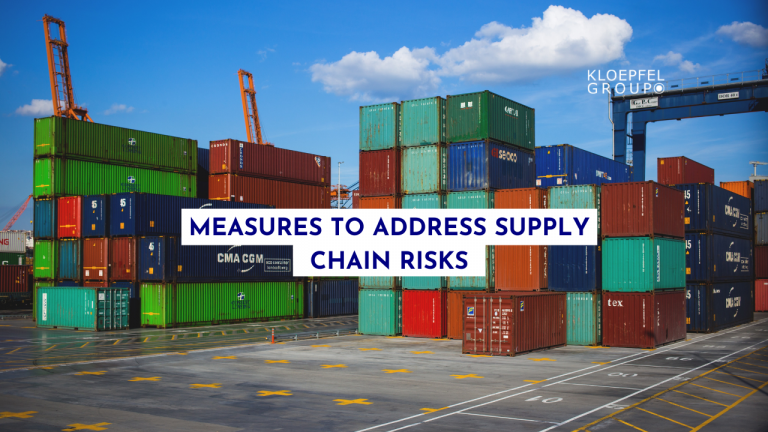Author: Dr. Stephan Hofstetter, Partner at Kloepfel Consulting.
As in the many crises before it, the current geopolitical situation underscores the importance of strategic supplier and risk management for many companies. Buyers and supply chain managers have learned from past crises and have recalibrated their assessment of opportunities and risks. The appetite for risk is significantly lower than it was just a few years ago. Accordingly, more and more companies are reassessing supply chain risks and aligning purchasing strategies. Below, we outline selected measures to address current risks in a global context.
Trend towards global decoupling
Many companies are responding to the Taiwan conflict and dependencies on China with global decoupling. This is manifesting itself in the form of more consistent localization of sourcing and production by continent. Companies are seeking alternative locations for production and bringing supply sources closer to their production sites to shorten supply chains logistically and increase resilience.
Geographical diversification
To reduce dependencies and thus risks, companies are diversifying their production and supply chains geographically. For example, companies are relocating production facilities and supply sources from China to other Southeast Asian countries. Due to their lower labor costs, investment incentives and relative political stability, Vietnam and Indonesia, for example, have become attractive locations.
Procurement trend nearshoring
Another procurement trend against the background of geopolitical and other global risks is nearshoring. Companies are looking to concentrate their suppliers near their plants or their sales markets. In Europe, these are countries such as North Africa, Southern Europe, Eastern Europe or Turkey.
Nearshoring reduces dependencies on logistically long supply chains that can be affected by political or climatic risks. It also shortens delivery times and reduces risks for transport logistics. However, nearshoring can also mean higher production costs.
Localization of production and procurement
Many companies are also focusing on localizing their production and procurement by setting up production sites and localizing procurement in the countries where they sell their products or where they expect demand to be high. This allows them to get closer to their customers, respond more quickly to changes in demand, and reduce the cost of transporting goods.
An example of this is when a German company that has a plant in China also expands its sourcing there to meet the demands of Chinese customers. If the company does not manufacture in China and does not have local suppliers, it will have difficulty distributing its products in China.
This trend toward localization by continent also shows that competition for global markets is increasingly taking place at the regional level. Companies must be able to understand and meet the needs of their customers in target markets in order to be successful.
Basic measures for resilient supply chains
To make supply chains more resilient, there are other fundamental measures that companies are examining. For example, a two-supplier strategy has become established in order to avoid supply bottlenecks caused by the failure of one supplier. This involves either dual sourcing, whereby goods are procured from two suppliers, or second sourcing, i.e. the option of procuring goods from a second supplier. Both variants differ from single sourcing, in which goods are deliberately procured from only one supplier. In the case of a sole source, there would only be one supplier at all.
Due to the fragile supply chains, companies are bringing parts of their production that were previously sourced from suppliers back in-house as part of insourcing. This reduces the risk but ties up more capital and resources. The know-how, skilled workers and necessary facilities must be built up.
In turn, buffer stocks for important raw materials or preliminary products can cushion bottlenecks in the event of a crisis. Since additional warehousing costs are incurred here, capital is tied up and the risk of obsolete goods is latent, careful consideration should be given to what safety stocks are created for and in what form. Inventory management should be transparent.
Open and cooperative communication with key suppliers as well as customers is also important in order to identify risks in good time and find joint solutions. Supplier visits and continuous evaluation of suppliers are important approaches.
Similarly, companies should regularly train and educate their employees to raise awareness of potential risks in strategic procurement and operational sourcing, as well as provide them with the skills to respond to unforeseen events.
Last but not least, companies are increasingly driving the digitization of their supply chains by automating order processes or enhancing shipment tracking, for example.
Through digitalization, processes can be made faster, more efficient, and more transparent, contributing to avoiding bottlenecks. Additionally, by utilizing data on suppliers, transportation routes, or order backlogs, a foundation is established for an early warning system to detect and eliminate disruptions in the supply chain. Transparency in the supply chain is crucial for effective risk management. Therefore, monitor your supply chains through real-time tracking and predictive analytics. Kloepfel Consulting can provide you with expertise and tools to support you in this regard.
Once a risk management system is implemented within a company, the “additional” effort in daily operations is minimal. The costs that could be incurred, for example, by a sudden supplier failure, are much higher than the expenses for implementing and operating a well-founded supply chain risk management system.
Seeking external assistance
The need for functional risk management in purchasing has grown strongly. Kloepfel Consulting supports its customers with the necessary know-how, tools and, above all, with the time that is often lacking in a purchasing department to establish a holistic risk management system.
Part 1: Geopolitical risks – challenges for supply chains
Part 2: Measures to address supply risks
Part 3: Checklist: 6 steps to avert supply risks
Risk management in procurement
.On this topic, Kloepfel Consulting offers you risk analyses, the development of concrete methods and measures to deal with risks, as well as training courses and workshops.

Arrange a non-binding consultation
Contact Dr. Stephan Hofstetter, Partner at Kloepfel Consulting, for a first phone call or web meeting by e-mail s.hofstetter@kloepfel-consulting.com or by phone +49 211 941 984 33
